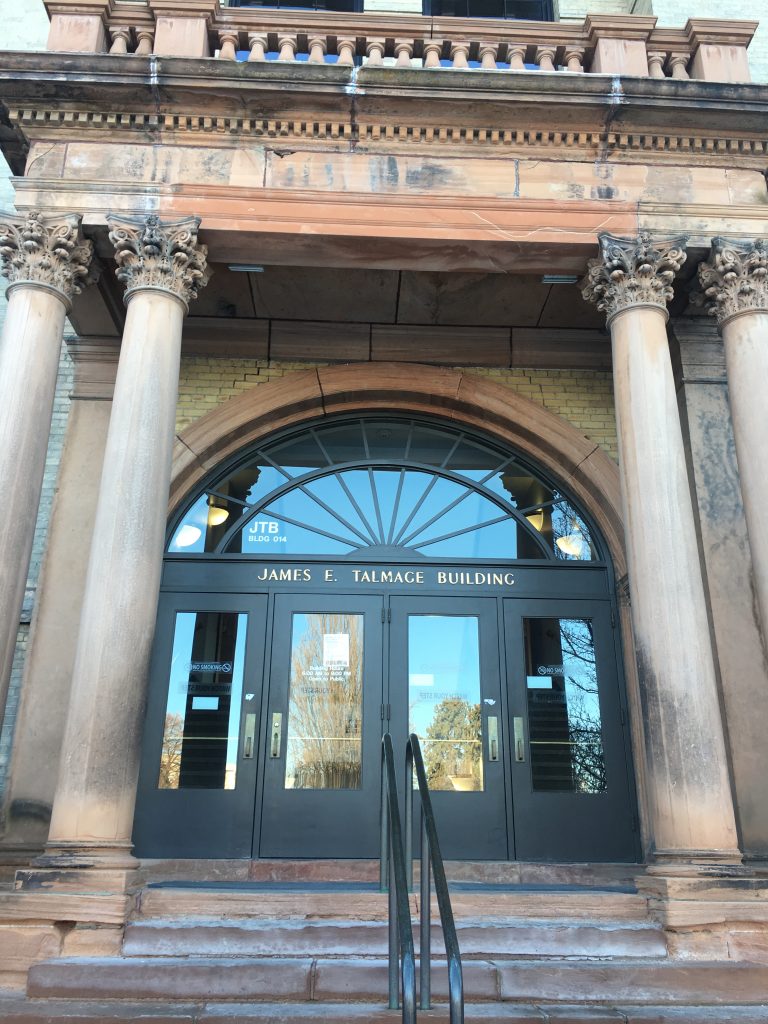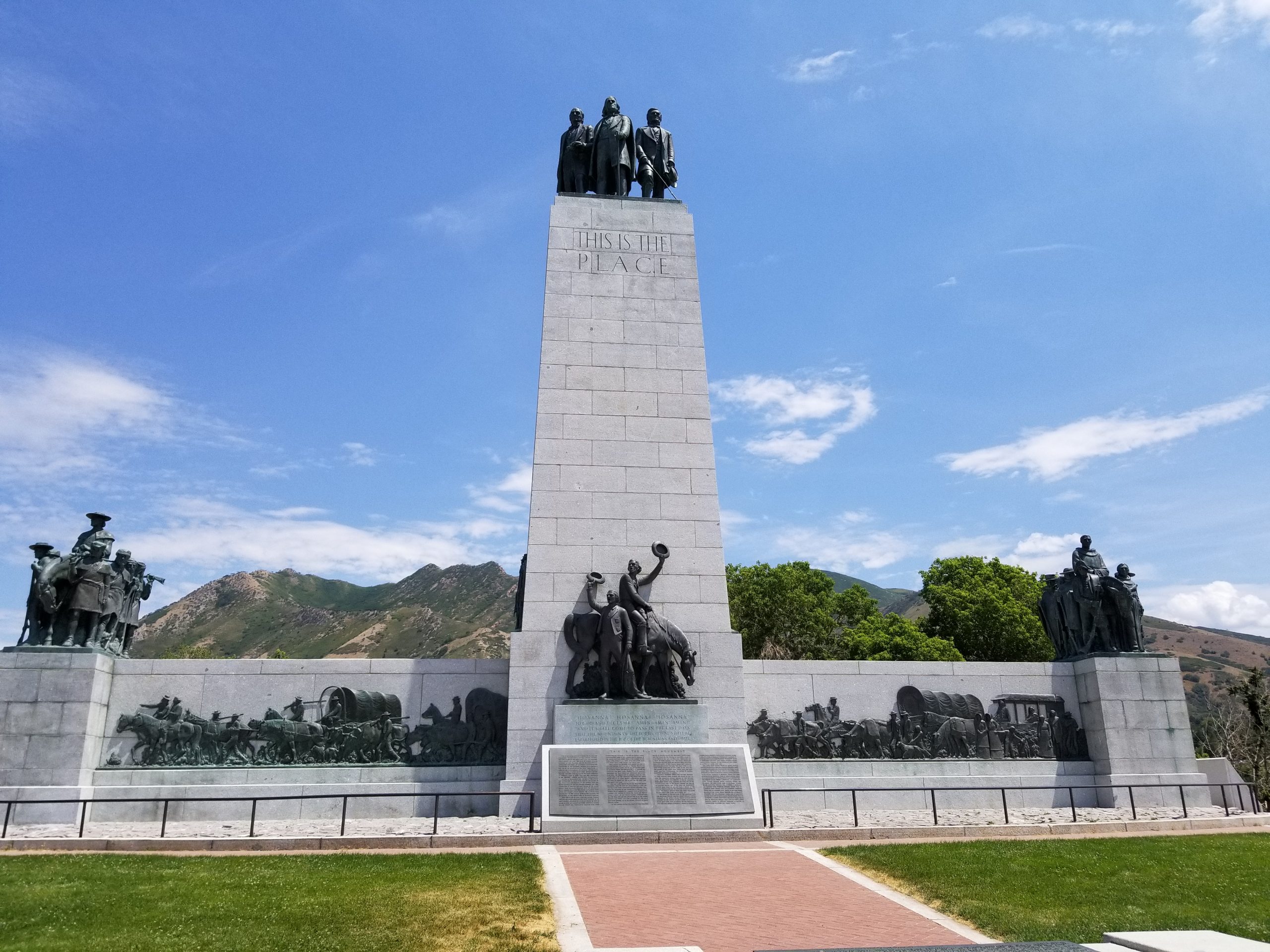Write up by Courtney Taylor
James E. Talmage Building
Placed by: The University of Utah Alumni Association
GPS Coordinates: Latitude: 40º 45’ 51.702” N Longitude 111º 50’ 58.59” W
Historical Marker Text
James E. Talmage-scholar, scientist, educator, author, and church leader-was born in England and came to Utah when he was ten years old. He earned the A.B degree at Lehigh University. and the Ph.D at Illinois Wesleyan University. For his work in chemistry and geology he was elected to membership in the Royal Society of Edinbirgh. He gave vigorous leadership to the University as Professor of metallurgy and biology, as Deseret professor of geology and as the University’s second president from 1894 to 1897. His major educational concern was to build a sound system of teaching for the people of Utah who, in the 1880’s were still somewhat remote from the established centers of learning, and to incorporate into the University curriculum the expanding body of scientific knowledge.

The land on which this building stands was deeded to the University during President Talmage’s administration. Construction of the building, to be known as the Museum, was begun in 1900, but so many new buildings were going up in Salt Lake City that skilled laborers and quality brick and stone were in short supply. The building was not completed until late in 1902.
The Museum building contained classrooms, offices and laboratories for biology, geology and mineralogy; geological and biological museums; an assembly room and gymnasium. About 1920, geology classes were relocated and the Museum become known as the Biology Building until, on June, 1976 in ceremonies sponsored by the Alumni Association, it was officially named the James E. Talmage building.
Extended Research:
James E. Talmage was a respected member of the academic community as well as a leader in the Church of Jesus Christ of Latter-day Saints. Talmage was the fourth president of The University of Utah from 1894-1897 but it was not until 1976 that the building was named the James E. Talmage building.
Talmage had a life full of educational and academic success. He grew up in Provo, Utah and worked at Brigham Young Academy (now Brigham Young University). He had a love of knowledge and pursued degrees in chemistry and geology. He studied at Leigh University and Johns Hopkins University. He became one of the first Mormons to receive a PhD.1 After his time as president of the University of Utah he was called to the Quorum of the Twelve Apostles of the Church of Jesus Christ of Latter-day Saints. While he was an apostle he also published a book well known in the Church called Jesus the Christ.
He took his job as University of Utah president very seriously and in correspondence with Elder John M. Whitaker he mentioned that it was “hard for me to do any lecturing outside the regular lectures at the institution”.2 He worked hard and he accomplished a lot in his academic life and took his job very seriously as president of the university. He was busy in his church life as well as home life as he was a father to eight children. Eventually he died from inflammation of the heart on 21 July 1933.3

The James E. Talmage building’s purpose changed over time. It was first erected as a museum building in 1902 but has primarily served as a science building. The building was built by architects Samuel C. Dallas and Williams S. Hedges who designed the building in a second renaissance revival style as the unique columns in the front of the building attest.4

The medical school took over use of the building from 1905-1920. In 1959 it was changed to the biology building to accommodate classrooms for a growing student population. Then in 1976 the building was renamed the James E. Talmage building in honor of the former university president. It is located in President’s Circle and the building is still used for science related studies.5
1 Bowman, Matthew Burton. The Mormon People: The Making of an American Faith. New York: Random House, 2012.
2 “Correspondence between John Mills Whitaker and James E. Talmage.” James E. Talmage to John Mills Whitaker. January 25, 1894.
3 Hardy, Jeffery S. “Mormon Missionary Diaries.” https://lib.byu.edu/collections/mormon-missionary-diaries/about/diarists/james-edward-talmage/
4 1992. https://preservationutah.org/images/stories/education/uofupresidentscircle.pdf.
Primary Sources
1992. https://preservationutah.org/images/stories/education/uofupresidentscircle.pdf.
“Correspondence between John Mills Whitaker and James E. Talmage.” James E. Talmage to John Mills Whitaker. January 25, 1894. https://collections.lib.utah.edu/details?id=917332
Secondary Sources
Hardy, Jeffery S. “Mormon Missionary Diaries.” https://lib.byu.edu/collections/mormon-missionary-diaries/about/diarists/james-edward-talmage/
“James E. Talmage (1862–1933).” James E. Talmage (1862–1933). https://www.lds.org/study/ensign/2010/03/small-and-simple-things/james-e-talmage-1862-1933?lang=eng.
“James E. Talmage Building.” Digital image. https://collections.lib.utah.edu/details?id=1036000.
